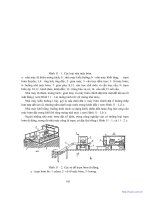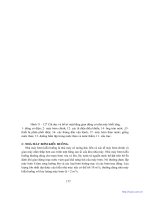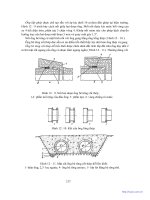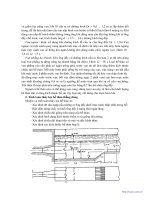Mechatronic Servo System Control - M. Nakamura S. Goto and N. Kyura Part 1 ppsx
Bạn đang xem bản rút gọn của tài liệu. Xem và tải ngay bản đầy đủ của tài liệu tại đây (635.52 KB, 15 trang )
Lecture Notes
in Control and Information Sciences 300
Editors: M. Thoma · M. Morari
Springer
Berlin
Heidelberg
NewYork
Hong Kong
London
Milan
Paris
Tokyo
M. Nakamura S. Goto N. Kyura
Mechatronic
Servo System
Control
Problems in Industries
and their Theoretical Solutions
Translated by Tao Zhang
With 79 Figures and 21 Tables
13
Series Advisory Board
A. Bensoussan · P. Fleming · M.J. Grimble · P. Kokotovic ·
A.B. Kurzhanski · H. Kwakernaak · J.N. Tsitsiklis
Authors
Masatoshi Nakamura Satoru Goto
Department of Advanced Systems Department of Advanced Systems
Control Engineering Control Engineering
Saga University Saga University
Japan Japan
Nobuhiro Kyura Translator:
Department of Electrical and Tao Zhang
Communication Engineering Intelligent Systems Research Division
Kyushu School of Engineering National Institute of Informatics
Kinki University Japan
Japan
Translation from the Japanese edition
© Morikita Shuppan Co., Ltd. 1998
All Rights Reserved.
ISSN 0170-8643
ISBN 3-540-21096-2 Springer-Verlag Berlin Heidelberg New York
Library of Congress Control Number: 2004103117
This work is subject to copyright. All rights are reserved, whether the whole or part of the mate-
rial is concerned, specifically the rights of translation, reprinting, reuse of illustrations, recitation,
broadcasting, reproduction on microfilm or in other ways, and storage in data banks. Duplication
of this publication or parts thereof is permitted only under the provisions of the German Copyright
Law of September 9, 1965, in its current version, and permission for use must always be obtained
from Springer-Verlag. Violations are liable for prosecution under German Copyright Law.
Springer-Verlag is a part of Springer Science+Business Media
springeronline.com
© Springer-Verlag Berlin Heidelberg 2004
Printed in Germany
The use of general descriptive names, registered names, trademarks, etc. in this publication does
not imply, even in the absence of a specific statement, that such names are exempt from the relevant
protective laws and regulations and therefore free for general use.
Typesetting: Data conversion by the authors.
Final processing by PTP-Berlin Protago-TeX-Production GmbH, Berlin
Cover-Design: design & production GmbH, Heidelberg
Printed on acid-free paper 62/3020Yu-543210
From theMain Author
As amain author of Mechatronic ServoSystem Control (in Japanese), Iwould
like to express my thanks to Dr. Zhang Taowho translatedour book into
English. The authors, myself, Dr. Goto and Prof. Kyurapublishedthe original
book whichmainly consisted of theauthors’ originalresearchachievement
of mechatronic servosystems control duringlast overten years. Theoriginal
book wasfortunately awarded as thebest book fromthe SocietyofInstrument
andControl Engineering (SICE in Japan) in 2001. Moreover, the book was
alreadytranslatedintoKorea language by aKorean publisher. As the authors
believethatour book is effective forstudents and engineerswho areinvolved
in the field of Mechatronic Controland Robotics, we have been intended
the translationofitinEnglish. The authorsthemselves made the Japanese-
English dictionaryfor theterminologies in the book, andask to Dr. Zhang
Taofor thetranslation of thebookbyuse of thedictionary.Dr. Zhang Tao
hascompletedthe translation by use of his every night times duringlast
severalmonths. Iwould like to showmygreatgratitude forhis effort for the
translation. Ialso express my great thanks to Prof. JeffreyJohnsonand Dr.
MikeRichards(Open UniversityinUK) who helped the final checkofthe
translation.
November 2002 Main author Masatoshi NAKAMURA
From theTranslator
Since the term ”Mechatronics” wasfirst introducedbyaYaskawa Electric en-
gineerin1969, andits rigorous definition wasgiven by atechnical committee,
i.e., The International Federation forthe TheoryofMachinesand Mecha-
nism(IFToMM), as “ Mechatronics is the synergistic combination of precision
mechanical engineering,electronic control, and systemsthinking in design of
productsand manufacturing processes”, the developmentofmechatronic tech-
niques has led to widespread adoption of electronics in machinery.Atthe same
time,asone of thekey techniques of mechatronics, servocontrol system has
been well defined for various kinds of mechanical system.Atpresent, mecha-
tronic techniques areessential for advanced mechanical engineering. Further-
more, the introductionofservocontrol system designtoengineers engaged in
mechanical engineering is thought to be indispensable.
As aresearcher on mechatronic technique, when Ifirstly readthe Japanese
version of this book ”Mechatronic ServoSystem Control”, written by Prof.
Nakamura,Dr. Goto andProf. Kyura,Iwasattracted by its meticulous study
on the issues of mechatronic servocontrol system arisingfrommechanical en-
gineeringaswell as the significance of application. Additionally,Iarouseda
strong desiretotransferits valuable achievements to whole researchersand
engineers who areengaginginthe mechatronic techniques or willingtoob-
tain knowledgerelated with mechatronic techniques. After Iheard that this
book wasawarded the 2001 Works Reward of TheSocietyofInstrument and
Control Engineers (SICE),and Prof. Nakamura alsohad thesame desire to
translate it into other languages forreaders, Iexpressed my strongwish to be
responsible fortranslating thisbookintoEnglish. With deeptrust andgreat
encouragementfromProf. Nakamura,Istarted this challengingprojectfrom
oneyear ago.
Through the great efforts, the English version of ”Mechatronic ServoCon-
trol System” wasfinished recently. As Iread the English version of this book
once again,Ihave alsoobtainedgreatenlightenment fromit, particularly for
my furtherresearchonmechatronic techniques. From thecontentsofthis
book, Ibelieveall readerswill share the same feeling. The profit of this book
VI
II
Fr
om
the
Tr
anslator
will be reflected notonly in the researchorteachingonmechatronic tech-
niques, butalso for engineersworking on mechanical engineering.
Finally, Ialso want to express my great gratitude to Prof. Nakamura,
Dr. Goto andProf. Kyura to distribute suchagreat valuable book on their
achievements within several decades of yearstowhole readers.For thekindly
help from Dr. D. Kushida duringthe periodofmytranslation,especially
the valuable review of this book fromProf. JeffreyJohnsonand Dr. Mike
Richards, Open University ,UK, Itransfermydeep appreciate to them.
Because of my insufficiency of knowledge on translation between Japanese
and
English,
therem
igh
th
ave
some
mistake
si
nt
his
bo
ok.
It
will
be
ve
ry
kind
if
yo
uc
an
indicate
them
to
me
andI
will
mak
em
yb
est
efforts
con
tin
uously
to improve them.
November 2002 TaoZHANG
Preface
The editorand composerisengaginginthe study on systemscontrol and
theirapplicationsinuniversity. As one of his researchfields, with aplenty of
opportunities of discussion with Kyura,who is long-term working on theservo
controller design and its application in mechatronic industry, on thecontrol
of mechatronic machine during the past tenyears, the cooperativeresearch
has been made greatly progress. These discussion meetings were heldseveral
times once ayear. Achievements on the items of these discussion meetings were
compiledintoreports, eachofwhichhas between 50
∼ 100 pages.Then, many
valuable commends were obtained fromKyurainterms of these achievements.
Moreover, new researchdirections were found. The distributionsofco-authors
arethat,
Kyura illustratedthe issuesonthe controlinthe servoparts of an indus-
trial robotadoptedinindustry,numerical control working machine, three-
dimensional measurementmachine,amechatronic machinecalled achip
mounter, etc.;
Nakamura explainedtheseissues in systems control theory and formulized
the obtained crucial points of problem solution;
Goto made computer simulations for the solution of these problems as
well as verifiedthe appropriation of thesedistinct theoretical results by us-
ing mechatr onics-relatedexperimental devices in the laboratory.Inaddition,
amongthe undergraduate students,master students,doctor students who
have interests in the control of mechatronic servosystem, some items were
allocatedtothem andthe relevantachievements were obtained by research
supervision. So far, about60conference presentationsaswell as 20 reviewed
papers on the mechatronic control have been completed.
Based on the above researchstory,the motivation of writingthis book was
written down. Through the question answeringinthe conference forpresenting
the obtained researchachievementordealing with the paper reviewers or the
conversation in thevisiting the universities or researchinstituteswhichare
doing researchonrobot manipulator, we feltstrongly that alot of researchers
XP
reface
or engineershave manymisunderstandingonthe alreadysolved problems in
industry.
In fact,accordingtothe words of coauthor Kyura,the strategiesfor the
encountered problems in the servocontroller designinindustry depending on
theexperien ce with trial errors of designersand engineers arejust responding
to the demandofthe world. These technologieshave notbecome distinct in
the so-called know-howworld.Since they are not logical strategies, even suc-
cessfully performing them, there arestill manycasesthatthe understandable
explanation can notbeobtained. In industry,eventhe clarification of theun-
desiredp
oin
ts
wa
sc
onducted
concretely
,t
he
cont
en
ts
are
not
announced.
It
is
still
in
the
presen
tc
onditiont
hatw
hy
the
go
od
pursuiti
sh
ardly
realized.
Throughthe collab oration,the essence of problems encountered in indus-
try wasanalyzedand formulizedlogicallyand mathematically. Accordingto
the solution of derived equations and the verification of justifiabilityofthese
results, many useful itemswere obtained.Atthe presenttime, these items
are summarized systematically.The opaquetechnologies under the name of
know-howuntil noware explaineddistinctly.Therefore, many researchers or
engineers canknowthem widelyand effectively use them. These are the mo-
tivationofwriting thisbook.
The problems discussed in this book arebase donthe common needs of
industriesrather than thepending problem areasofone researchengineer in
industry.The resultsfor them,whichwere being caughtempirically until now,
are clarified logically.Therefore, the resultsare adaptedfor areal machine,
and various performancesorcontrol methodsofcontroller designpreviously
determinedwith the experience of an expert can noware decidedlogically
basedonthe adopte dresults. Moreover, aknow-howonly suitable forspecial
situations until now, is changed into amorecomplicated andmoreingenious
universal technology.This book is unique in handling these problems.
The organization of this book is that, thedesign of the servocontroller of
mechatronic servosystem is with respect to the fieldsofmodeling, analysis and
controller design control. It is from the introduction to the following chapters
till 7.
In theintroduction, the outlineofmechatronic servosystem and its main
points of the problem in industryare given.
In chapter2,theseproblems aresolved reasonably,whichare the achieve-
ments of cooperativeresearchofco-authors. In eachchapter, main points are
attached.
The presentconditions andproblems in industry,main results, significant
of resultsaswell as the explanation of the main points of applications about
eachitem are conducted at the commencementofeachchapter.
It is acceptable even if thereader reads this book fromthe beginning.For
thereader who wantstolearn with the purpose of understanding, it is also
good to learn eachsection of one chapte rfor dealing with the problems which
arecombinedfromthe problems personallyheld and described in introduction.
In eachsection of eachchapter, main points are inserted at the beginning of
PrefaceX
I
eachsection for recommending the text readingthoroughly.The contents of
eachsection are based on one of authors’ papers whichisspecified with the
quotation article number in the place of the bibliographylist. Finally,the
book contains an index,aglossaryofterms, acollection of symbols anda
description of theexperimental devices used in our experiments.
During preparation, the book wasread with distr ibu tion of sections of this
book by seven master students of dep artmentofadvancedsystems control and
engineering, graduate school of science and engineering, Saga university(Mr.
ShigetoAoki,Mr. TatsuroKatafuchi, Mr. DaisukeKushida,Mr. KentaShira-
masa,M
r.Sho
jiro
Ya
magami,
Mr.M
asashi
Ta
mu
ra,M
r.
Minoru
Nishiza
wa
).
Referringt
ot
heiri
mpressions
of
the
bo
ok,
theb
oo
kw
as
revised
to
impro
ve
readability. The significance of the problems took up it in this book andthe ef-
forts areinmaking the essence of aproblemtothe formula appropriately.The
keys to solution of manyformulas are the easily adopted basis of classicalcon-
trol (Laplacetransformation)ormodern control (differential equation) learnt
with the universitybachelor degree,and the most fundamental knowledge in
the control theory explained in appendix. Therefore, not only the enterprise
directly related with system control or postgraduate students of universityor
researchers,but alsothe undergraduate students with the purpose to makethe
theorylearntinuniversityintopracticecan be expected to read it widely.We
expect that the knowledge obtained from this book can be adoptedwidely in
mechatronic in du stri es, and expect simultaneously that the researchplanted
the root in this kind of ground will be expanded at the researchinstitute etc.
of an enterpriseand, expecially and university.
At the end of the preface, since the materials of this book areall ob-
tained from the cooperativeresearch, the conditions of cooperativeresearch,
thoughts and feelings aroused from the cooperativeresearch, are written as
below, though it mayberedundant.
1. The cooperativeresearcher should be proficientineachfield.
2.
Keep
frequen
td
iscussion
for
al
ongt
ime
among
co
op
erativ
er
esearc
hers.
3. Respect the views of the partner mutually.
4. Fine mutual human relations.
Concerning the writingofthis book, Mr. Kojiro Kobayashi, Department
of productionofthe Morikitapress, andMr. Shoji Ishida,Departmentof
compilationofthe Morikitapress, took careofitvery much.All my great
gratitude arehere expressed.
October 1998 Editor-composer Masatoshi NAKAMURA
1
OutlineofMechatronic ServoSystems
The mechatronic servosystem is the major theme studied in this book. In
particular,the servosystem adopted in an electric servomotor is explainedin
this chapter. Severalitems of its utilization from the developmentstagetothe
presentaswell as its performances. The so-called mechanismmachine (called
as mechatronic servosystem at the following), i.e., the servosystem adopted
in the numerical control machineorindustrialrobot, is generallydifferent
from the servosystem intro du ced in the textbookofautomaticcontrol, which
is very important when discussing the mechatronic servosystem.
Firstly,the control pattern assigned in mechatronic servosystem is illus-
trated.The properties of currentservosystem satisfying the control pattern
and its utilization are introduced. Next, as the discussion items, the analysis
on mechatronic servosystem and its utilization are carried out.
1.1
Emergence
of
Mec
hatronic
Serv
oS
ystems
1.1.1 Control Pattern of Mechatronic Servo Systems
The mechatronic servosystem, as the control system satisfying the motion
conditionsoftransferaxis of numerical control machine, wasoriginally(about
1967) created when developingthe DC servomotor .Then, in 1975 by Yaskawa
Electric,the velocitycontrol equipment(servodriver unit)unifiedthe compen-
satorofcontrol system andpoweramplifier wassold.Initially, it wasmainly
adoptedfor thetransferaxis control of working machine. From 1980, it was
alsoadoptedfor theposition andvelocitycontrols of various kinds of mecha-
nisms suchasthe industrial robot. At the generation of this mechatronic servo
system, the control pattern,asthe startpointofservosystem construction,
is according to the following.
1. The velocityoffset for step-shapetorquedistur bance is below
n [rpm] (gen-
erally below1[rpm]).
M. Nakamura et al.: Mechatronic Servo System Control, LNCIS 300, pp. 1–15, 2004.
Springer-Verlag Berlin Heidelberg 2004
21
Outline
of
Mec
hatronic
Serv
oS
ystems
2. Thevelocitycontrol ratioisone to severalthousands (minimum1[rpm]
and maximum 3000–5000[rpm]).
3. The capabilityofpoweramplifier is effectively adopted (regulationtime
is shortened from the rated currentacceleration/decelerationadoptedfor
limitedvalue) .
Concerning the above three items, their necessityand significantinappli-
cation areintroducedrespectively.Inthe transferaxis of aworking machine,
the pattern is determined from the motionofinstalled in tools forcutting
or rotative cutting. Therehas thecontactofthe blades of thesetools with
proc
essed
prod
uct
andt
he
load
to
transfer
axisa
se
nt
eringt
oo
ls
is
the
motion
friction
torque
added
constan
tly
.W
hen
starting
the
pro
cess,t
here
is
negative
force of processing in the transferaxis installed in tools. Certainly,the degree
of negative force is different fromthe processing state.The negative force con-
ducted at this time can be regarded as thestep-sh apetorqu eload.This torque
load is added as thetorquedisturbance to motorincontrol system.Therefore,
at this time,the velocityoffset is appeared, and the error of processed shape
with designed shapeisgenerated by the transfer axis. Hence, thereexists the
phenomenon of unexpected velocityoffset duetotorquedisturbance.
The second item is necessary when acircular trajectory cannot be ap-
proximatedbyapolygon. In order to realize the circular trajectory,itisvery
difficult to accurately generate analogous sinusoidal or cosine instructions.
Therefore, when generating the circular trajectory,the straight-line command
approx
imating
the
circular
tra
jectory
by
po
lygoni
sg
iv
en
with
considering
the
velocityfor thetwo-axis servosystem constructing aplane. In order to move
with constantspeed along one edge of the polygon, two axesmust move ac-
cording
to
the
ve
lo
cit
yr
atioc
orrespo
nding
to
the
axisi
ncline.A
tt
he
edges
orthogonal between
x axisand y axis, theirvelocityisinfinite. To understand
thiscase easily, the velocitycommandofdriving system causing oneaxis mo-
tion
should
be
needed
fromz
ero
to
infinite
in
theory
.I
nf
act,t
he
edgen
um
be
r
of approximatedpolygon is determinedbythe velo citycontrol ratioofthe
driving system which can actually be implemented.
The
thirdi
tem
is
required
by
op
erational
efficiency
andp
owe
ra
mplifier
economics. The operational efficiency is evaluated by the actual operation
time of the mechanism for an element, for example, the time of mechanism
motionfrombeginningtoend. Therefore, the time without cutting by knifeis
expected to be minimum. Moreover, areduction in the time needed to reach
the constant speed (regulation time of speed) is also attempted. However,
it is notpermittedtocost so much forthis purpose.Ingeneral, the cost
of apoweramplifier is affected greatly by its outputvoltage andpermitted
maximalcurrent. Thus, in the velocitycontrol, it is requiredthatthe power
amplifier is adop tedwith its maximalcapability(allowance current)and the
acceleration/deceleration time is shortened.
The structure of amechatronic servosystem designed for satisfying these
performancesisillustrated in Fig.1.1 for DC motor. As an aid to understand-
1.1E
mergence
of
Mec
hatronic
Serv
oS
ystems
3
ing the figure, generally,the position control is designed as ratio control and
the velocityaswell as currentminor-loop in its insideisdesigned. Moreover,
in the structure of poweramplifier, PWM amplifier is alwaysadopted. The
carrierfrequencyofbasicwave when usingthis PWM is fromseveral to afew
dozens [kHz] is used.
The structurecomponentofthis mechatronic servosystem is changed from
the originalDCservomotor to an AC servomotor.Moreover, the controller
using position, velocity, currentloopcan be alsochanged into asoftware servo
system with asof tware algorithms using amicro processor, from the original
hardwa
re
computing
amplifier.
1.1.2 Characteristic of Servo SystemApplications
The emergence and structureofmechatronics have been briefly introduced in
the former part. In order to understand that the usage of this mechatronic
servosystem is differentfromthe general servosystem, the main points are
listed as below.
1. In amechatronic servosystem, thereare two typesofcontrol. Oneispo-
sition control (PTP:pointtopoint) emphasizing the arriving time and
stop position from anyposition withoutconsidering the response route.
Anotheristhe contourcontrol (contouring or CP:continuouspath)em-
phasizing the motiontrajectory fromthe current position to thenext
position (positionateachmoment andits motionvelocity). These shapes
are shown in Fig.1.2. The former one is the robot arm for elementassem-
bly,spotwelding, etc, or used for the control of moving axis of mechanism
for drilling ahole.The latter oneisthe armofweldingrobot, painting
robot, laser cuttingrobot, etc, or usedfor thecontrol of transfer axi s
of mechanismimplementing anythree-dimensional shapeprocessing (ma-
chine center, etc).
2. In the contour control, the servosystem, as aposition control system,
requiresstrict velocitycontrol formanykindsofresponse. Concerning
the robot for welding, the importance of velocitycontrol can be easily
K
K ( T s +1)
T s
K ( T s+1)
T s
1
( T s+1)
K
K s+1
1
L s+ R
K
1
J s
1
s
1
N
1
N
K
1
J s
1
s
D
p
i
i aa 1
oaa
τ
M
L
L
L
v
2
a
-
-
1
T s+1
f
v
K
e
s
-
G
G
P o s i t ion
c ontrol p a rt
P o s i t ion
c ontroller
V eloc i ty
c ontrol p a rt
V eloc i ty
c ontroller
C urrent
c ontroller
C urrent
c ontrol p a rt
V eloc i ty
filt e r
A x i s
r e s ona n c e
filt e r
P o w e r
a mplifier
A mplifier
p a rt
M o t o r
M o t o r
elec tri c te r m
T o r q u e
c onsta n t
S p r ing
c onsta n t
M e c h a nis m
p a rt
G e a r
G e a r
Fig. 1.1. Construction of position control system of one-axis mechatronic servo
system
41
Outline
of
Mec
hatronic
Serv
oS
ystems
understood.Inelectric weldingusing an automatic weldingmachine,after
setting voltageand current,the motion velocityofthe torch(the tool
spraying the finesolventcontinuouslyafterturning on thevoltage) is
determinedaccordingtothe heatrate given alongthe curveofweldin g.
Therefore, the motionvelocityofthis torchischanging while the given
heatrate is alsochanging.Ifthe overheat rate is throwninto, themouth
of relevantpartisopened andthe appropriate weldingwhichshould be
with little given heat rate is impossible. In addition, for apainting robot,
if the motionvelocityofpainting canischanged, the spot of painting is
easily
appe
ared.B
esides,
in
the
cuttingo
pe
ration
of
va
rious
materials,
ke
epingt
he
constan
tc
utting
ve
lo
cit
yc
an
guaran
teet
he
cutting
quality
.
3. In thecontourcontrol, an overshoot in theposition control system should
notoccur.Inmanycases, velocitycontrol system is alsoregulated so that
the overshoot cannotoccur.Inthe various kinds of actualprocesses,the
generation of overshoot of position will cause fataldefect of shape. For
example, in the process of constructing ashaft, if an overshoot occurs,
the radiusofthe part becomes smaller, reducingthe strength of this part.
Moreover, if the vibratedtrajectory exists insufficiency of shape, it cannot
be revised at thelatermotion.
4. Theobjectivecommandtoservosystem is obtained correctly before con-
trolinmanycases. It can be said that, the elementsize, setting method,
etc, of operation object of robot or process object of working machine can
be completely known before starting the desiredoperation.Inaddition,
the motion velocityatthis time is alsodefinitely determined.Therefore,
the tract information necessary formotion is knownbefore starting con-
trol. In addition, it can be supposed that external disturbance is mixed
into the control system. When the mixed disturbance overthe supposi-
tion,concerning the safetyofequipment, the motionofcontrol system
should be stopped and the powersource fordriving should be isolated
P
P
P
i
i-1
i+1
x
y
0
Fig. 1.2. PTP control and CP control









